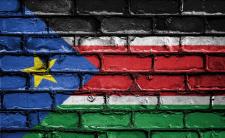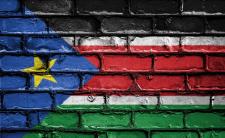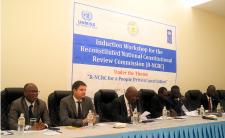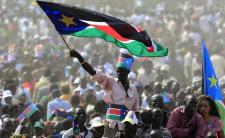Introduction
On July 9th, 2011 the Republic of South Sudan became the world’s youngest nation when the people overwhelmingly voted to secede from the Republic of Sudan. A landlocked country in east-central Africa, South Sudan shares boundaries with Ethiopia to the east, Kenya to the southeast, Uganda to the south, Democratic Republic of Congo to the southwest and the Central African Republic to the west. South Sudan also shares a contested-undefined northern border with the Republic of Sudan. The 619,745 sq. km nation is home to roughly 7.5-9.7 million people majority of who are adherents of traditional tribal religions or Christianity. It is home to approximately 60 indigenous ethnic groups; the Dinka, Nuer and Bari are among the largest. In the capital city a version of Arabic, called Juba Arabic, is spoken. However, English is the official language of the country. Of the indigenous languages, more South Sudanese speak Dinka, Nuer, Bari, and Zande than any other language. Located in the agricultural rich region of Africa the nation of South Sudan is predominately pastoral, with very little infrastructure. The majority of the South Sudanese population depends on subsistence farming. The government of South Sudan derives nearly ninety-percent of its budget from oil revenues. However, due to quarrels with Sudan, for a long stretch of time the government was unable to produce any oil.
Constitutional history
In the tenth century the Nilotic people entered the current region of South Sudan, establishing many of the indigenous tribes still present in the country today. Coming from the Nile Valley region the Nilotic ethnic group includes two of the largest tribes in South Sudan; the Dinka and Nuer. The Nilotic people were followed by the Azandes in the sixteenth century, who established the largest state in South Sudan. Tribes in South Sudan were able to retain their cultural and religious heritage because of geographical barriers. These geographical barriers account for the cultural divide that exists between the Republic of Sudan and the Republic of South Sudan.
During the 1870’s, Egypt attempted to colonize the region by establishing the province of Equatoria as an outpost. A revolt by Mahdists revolutionaries -who were followers of a muslim cleric Muhammad Ahmad who declared himself the Madhi or redeemer of Islam - later in 1885destabilised the Equatorial province. This takeover of the Egyptian province did not go unnoticed by Europeans, because by this point control the Egyptian government had largely passed to the British. The Mahdist control of the region did not last long, because British forces overthrew the Madhist regime in 1898 and established a predominantly Christian Anglo-Egyptian Sudan. In 1953, the British granted Anglo-Egyptian Sudan self-government. Tension between the north and south surged at this point. Southerners accused the northern government of attempting to force Islamic and Arab culture on the South. In addition, the South also felt that the North had reneged on the promise of more autonomy through a federal system of government. Led by the Anya Nya guerrilla movement, a southern army mutiny sparked a civil war that lasted from 1955 till 1972. While the civil war was going Sudan officially gained its independence from Britain and Egypt in 1956.
The civil war was brought to an end by the signing of the Addis Ababa Agreement in 1972, which created the Southern Sudan Autonomous Region. This new autonomous region lasted until 1983, when the Sudanese government unilaterally withdrew the South’s autonomous status.. This led to renewed conflict, which lasted twenty two years, between the South led by the, led by the Sudan People’s Liberation Movement (SPLM) and its armed wing, the Sudan People’s Lib approximately 1.5 million lives and displaced over four million people.
A cease fire between the warring parties was declared in July 2002. This led to a 2 ½ years period of peace talks that concluded with the signing of a Comprehensive Peace Agreement in January 2005. The agreement restored the autonomy of the South and created a power sharing government. The 2005 agreement also give approximately half of Sudan’s oil wealth to the South. Most important to come out of the 2005 agreement was the right of self-determination granted to the South to be exercised via a referendum at the end of six years from the signing of the agreement.
Following the CPA and the regaining of autonomous status, South Sudan adopted an adopted an Interim Constitution to govern the transition period between the CPA and the referendum period. The Interim Constitution established the boundary lines between the North and South as they stood in 1956. Because South Sudan was part of the Sudan at this time, the Constitution was still subjected to the national law of Sudan. The constitution established a presidential system of government, with an executive, legislature, and independent judiciary. Head the government was the president who was Head of State, Head of Government, and Commander-in-Chief. The Constitution also established South Sudan as a decentralized government with ten separate states.
2011 Transitional Constitution
On July 9, 2011 South Sudan officially became an independent state following a referendum held in January 2011 in line with the provisions of the CPA (2005)Contemporaneously with the accession to independence was the adoption, by South Sudan’s Legislative Council, of a Transitional Constitution.. The purpose of this change was to reflect the new status of South Sudan as an independent republic disconnected from the North. . The Transitional Constitution provided for the creation of a constitutional commission to write a permanent Constitution for the new republic and established the key institutions to govern the affairs of the state during the transition. Pending the process of writing the permanent Constitution which remains ongoing, the Transitional Constitution remains the operating basic law of South Sudan.
The Executive
As set forth in article 97 of the Transitional Constitution, the President of the Republic of South Sudan is the Head of State, the Head of Government and Commander-in-Chief of the Sudan’s People’s Liberation Army and the Supreme Commander of all other forces. Presidential candidates must be South Sudanese by birth, forty years of age, sound mind, and cannot have been convicted of any offence involving honesty or moral turpitude. S/he is elected by universal adult suffrage for a four years term. The President has precedence over all other persons in South Sudan and is obliged to safeguard the Constitution as well as “execute and maintain the Constitution and all laws”. The President is immune from legal proceedings while in office. However, in cases of high treason, gross violation of the Constitution or gross misconduct in relation to national affairs, the President may be charged before the Supreme Court upon a resolution passed by a two-thirds majority of all the members of the Assembly. Additionally, the President has the power to appoint a Vice President after having obtained the approval of the legislature. The President may appoint a limited number of advisors and shall define their functions. Also, within the executive is the National Council of Ministers. The Council comprises of the President, Vice President and Minsters. The constitution stipulates that at least 25 percent of the council must be women.
The Legislature
The bicameral legislature consist the National Legislative Assembly and the Council of State. To be qualified for the National Legislature the candidates must be 21 years old, literate, of sound mind, South Sudanese, and have not been convicted of offence dealing with honesty or moral turpitude. Both Houses have a term limit of four years. The National Legislative Assembly has a speaker and two deputies, whereas the Council of states has a speaker and a deputy. Unless otherwise stipulated by the Constitution, legislation can be passed by a simple majority. If the President does not assent to a bill, with reason, a 2/3 majority can pass it into law. A member of the National Legislature, other than the Speakers, Deputies, Minority Leaders, Chairpersons and Deputy Chairpersons of the specialized committees, and Chief Whips, may hold any other office in the private sector, with remuneration or engage in any profit making business; provided that such office or business does not compromise his or her duty as a member.
The Judiciary
Part 7 of the Constitution established the independent Judiciary. The judiciary is responsible for the professional training and maintenance of professional standard for judicial personnel. The Constitution calls for substantial representation of women within the judiciary. The judiciary consists of the Supreme Court, Court of Appeals, High Courts, and County Courts. Other lower courts may be created in accordance with the Constitution and the law.
The Supreme Court is the highest court and consists of a Chief Justice, Deputy Chief Justice and no less than nine other Justices. A case is decided by a majority of a panel of three justices. For matters relating to the Constitution, the panel is composed of nine justices chaired by the Chief Justice. The rulings of the Supreme Court are final and binding on all institutions. The Supreme Court has original jurisdiction over matters arising under the Constitution. With approval of the Judicial Service Commission, the Chief Justice disciplines justices and judges.
Constitutional challenges
As mentioned earlier, one of the things provided for in the Transitional Constitution was the drafting of a permanent Constitution Unlike the Transitional Constitution which was written without public participation, the process of writing the permanent Constitution is expected to be more participatory and inclusive. Pursuant to the Transitional Constitution, the process kicked off with the establishment, by President Salva Kiir, of a National Constitution Review Commission (NCRC) in January 2012 for a one year mandate. However, the one year mandate elapsed without the Commission accomplishing much. The constitutional review stalled for a myriad of reasons. Budgetary concerns in part were at fault for the stalling of the constitutional review process. The government’s inability to pump oil, due to tension with Sudan, meant that it had lost approximately 98% of its budget.
However in March 2013 the NCRC had its official mandate extended for another two years, until 9 January 2015. The expectation is that the extended time frame will allow the Commission to engage in the important tasks of awareness-raising and public consultation. However, important questions about the process remain unanswered. Such as how long the consultation process will take; how widely the public will be consulted; what issues will be on the table to be addressed; and who will constitute the participating parties. Although the NCRC was not fully functional, civil society organizations in South Sudan began collecting the public views on the Transitional Constitution. This was all before the NCRC was able to “constitute its Secretariat, adopt its rules of procedure work plan, or initiate civic education”. The United Nations Mission in South Sudan began convening working groups of international organizations capable of providing the tools and education necessary for the constitution building process.
The SUDD Institute, a local independent research organisation has criticizes the NCRC of limiting its process to the select few with the public making very little contribution to the process. The United Nations Secretariat General Ban Ki-Moon also criticizes the slow process of South Sudan constitutional review process, but stated that more citizen feedback was welcome.
Compounding the problems and delays with the constitutional review process is also increasing corruption within the public sector.. Government officials have been accused of embezzling more than $2.5billion from the state. These allegations have angered many South Sudanese at home and abroad. Women groups are also calling for a set marriage age, so girls are not coerced into marriage, a provision not addressed in the Transitional Constitution.
System of Government under the Transitional Constitution
Timeline
| 10th Century | Nilotic people moved into the region at some point for the start of the century. |
| 16th Century | The Azande people enter the region and established the largest state in the region. |
| 18th to 20th Century | Dominance of the Avungara sib over the rest of the Azande people. |
| 1870s | Egypt established the southern province of Equatoria. |
| 1885 | Mahdist revolt overruns Equatoria. |
| 1899 | Establishment of Anglo-Egyptian Sudan |
| 1953 | Anglo-Egyptian Sudan is granted self-government |
| 1955 | Southern army mutiny sparks a civil was led by Anya Nya. |
| 1956 | Sudan is granted its independence from Egypt and England. |
| 1972 | First Civil war comes to an end with the signing of the Addiss Ababa. In this agreement the Sudanese President Jaafar Numeiri concedes some autonomy to the south. |
| 1978 | Oil discovered in Southern Sudan |
| 1983 | Second Civil War breaks out after Sudanese President Jaafar Numeiri abolishes the South Sudan Autonomous Region. The south is leg by the Sudanese People's Liberation Movement (SPLM) under the leadership of John Garang. |
| 1988 | A cease-fire agreement is drafted by the Democratic Unionist Party, but it is never implemented. |
| 1989 | The military takes control of Sudan. |
| 2002 July | The Sudanese government and the southern rebels signed a cease fire. |
| 2005 January | Comprehensive Peace Agreement signed, bringing an end to the twenty-two years long civil war. A power sharing government is established |
| 2005 July | New Sudanese Constitution gives allows for an autonomous south. |
| 2005 | The South adopts the Interim Constitution of South Sudan. |
| 2005 October 22 | Autonomous government formed in Southern Sudan under new SPLA leader Salva Kiir Mayardit. |
| 2007 October to December | SPLM briefly suspend participation in the national government, accusing Khartoum of failing to honor the 2005 peace deal. |
| 2008 | Intense fighting breaks out in the Abyei region. Omar Al-Bashir (Sudan’s president) and Salva Kiir agree to international arbitration. |
| 2009 | The Presidents of both Sudan and South Sudan accept a ruling by the Permanent Court of Arbitration that gives the Heglig oil field to the north. |
| 2009 | Agreement reached on the terms of the referendum on the South’s secession. |
| 2011 January 9-15 | People of South Sudan overwhelming vote to secede from Sudan. |
| 2011 March | South Sudan cancels talks accusing Sudan of plotting a coup. |
| 2011 May | Sudan takes control of the contested Abyei region. |
| 2011 June | North and South signed an agreement to demilitarize the contest Abyei region. |
| 2011 July 9 | South Sudan becomes the world’s newest Independent nation. |
| 2011 July 9 | Transitional Constitution of South Sudan comes into force. |
| 2012 January 9 | National Constitutional Review Commission established. |
| 2012 February | Sudan shuts down South Sudan’s oil pipe. Public spending cut in half on all but salaries of consequence. |
| 2012 September | Presidents of South Sudan and Sudan agree to trade, oil and security deals. |
| 2013 January | NCRC mandate is extended for another two years, until 2015. |
| 2013 March | Sudan and South Sudan agree to resume pumping oil. |
Bibliography
Akol, Zacharia Diing. "A Nation in Transition: South Sudan’s Constitutional Review Process." SUDD Institute. 17 Feb. 2013. 07 June 2013 http://www.suddinstitute.org/publications/policy-briefs/
BBC News. South Sudan Country Profile, 2013. Web. 2013 June 11. http://www.bbc.co.uk/news/world-africa-14019208.
Government of South Sudan. At a Glance, 2013. Web. 2013 June 11. http://www.goss-online.org/magnoliaPublic/en/about/history.html.
Guardian UK. The Dream of South Sudan is Fading Fast: I Cannot Yet Return. 2013. Web 2013 June 05. http://www.guardian.co.uk/commentisfree/2012/jul/10/south-sudan-africa.
Guardian UK. South Sudan: A Country Failing to Thrive After the Euphoria of Independence. 2013. Web 2013 June 05. http://www.guardian.co.uk/world/2012/nov/26/south-sudan-new-country.
InfoPlease. South Sudan, 2013. Web. 2013 June 11. http://www.infoplease.com/world/countries/south-sudan.html.
Justice Africa. An Examination of the Constitution Writing Process in South Sudan. 2013. Web June 11, 2013. http://www.justiceafrica.org/2013/05/22/an-examination-of-the-constitution-writing-process-in-south-sudan/
UK Foreign and Common Wealth Office. Country Updates: South Sudan. 2013. Web. June 11, 2013. < http://www.hrdreport.fco.gov.uk/human-rights-in-countries-of-concern/south-sudan/quarterly-updates-south-sudan/>.
United States. CIA World Factbook: South Sudan, 2013. Web. 2013 June 11. https://www.cia.gov/library/publications/the-world-factbook/geos/od.html.
United States Institute for Peace. Constitution Making in Sudan and South Sudan: Constitution Making and Rule of Law in the Two Sudans, 2013. Web. 2013 June 10. http://www.usip.org/programs/projects/constitution-making-in-sudan-and-south-sudan.
Voice of America. South Sudan Citizens Have a Say on New Constitution. 2013. Web. 2013 June 07. http://www.voanews.com/content/south-sudan-citizens-say-new-constitution/1628992.html.
| Branch | Hierarchy | Appointment | Powers | Removal |
|---|





